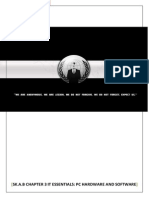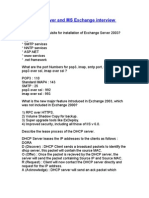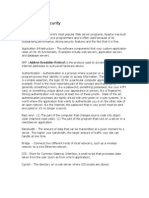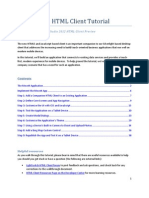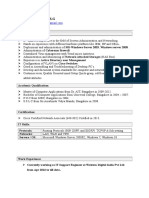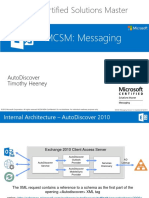Knowledge Assessment Answers 5
Knowledge Assessment Answers 5
Uploaded by
ruletriplexCopyright:
Available Formats
Knowledge Assessment Answers 5
Knowledge Assessment Answers 5
Uploaded by
ruletriplexCopyright
Available Formats
Share this document
Did you find this document useful?
Is this content inappropriate?
Copyright:
Available Formats
Knowledge Assessment Answers 5
Knowledge Assessment Answers 5
Uploaded by
ruletriplexCopyright:
Available Formats
640 (Windows Server 2008) Knowledge Assessment Answers 5
Lesson 5 Active Directory Administration
Knowledge Assessment Fill in the Blank
Complete the following sentences by writing the correct word or words in the blanks provided. 1.A(n) _global group_ can only contain members from within the same domain. 2.You can use the __CSVDE__ utility to import data from Comma-Separated Values (CSV) files. 3.Each user and group object has a(n) _SAM account name_, which must be unique across an entire Active Directory domain. 4.The Anonymous Logon group is an example of a(n) _special identity group_. 5.You can use the __LDIFDE__ command-line utility to create and modify Active Directory objects. 6.When users log on to Active Directory, they receive a(n) _access token_ consisting of all of their security group memberships. 7.A local user is stored in the __Security Account Manager (SAM)__ database of the computer on which it was created. 8.Each CSV file needs to begin with a(n) __header record__ when used with the CSVDE command-line tool. 9.A(n) __distribution group__ can only be used to send and receive email, not to secure network resources. 10.__Group nesting__ is the practice of adding one group as a member of another group.
Multiple Choice
Circle the correct choice. 1.Which special identity group controls anonymous access to resources in Windows Server 2008? a. b. c. d. Everyone Network Interactive Anonymous Logon
Prior to Windows Server 2003, the Anonymous Logon group was a member of the Everyone group, which had the potential to create significant security liabilities. Beginning in Windows Server 2003, anonymous access must be configured separately from access granted to the Everyone group. 2.What defines the types of objects that can belong to a particular group and the types of resources that group can be used to secure? a. b. Group scope Group security
640 (Windows Server 2008) Knowledge Assessment Answers 5 c. d. Special Identity group Security group
The domain local group scope can contain users or groups from any domain in the forest, but can only be used to secure resources in the same domain as the group. The global group scope can contain only users or groups from the same domain as the group, but can be used to secure resources from any domain in the forest. The universal group scope can contain users or groups from any domain in the forest and can be used to secure resources in any domain in the forest. 3.What technique is used to configure one security group as a member of another security group? a. b. c. d. Group security Group nesting Group overloading Group scope
If GroupB is nested within GroupA, the members of GroupB will receive the same permissions that have been assigned to GroupA. 4.The Administrator and Guest user accounts are examples of a. b. c. d. Special identity user account Administrative user account Built-in user account Domain user account
Built-in user accounts can be local accounts or domain accounts, depending on whether you are working with a member server or an Active Directory domain controller. 5.Which command-line tool can be used to create various object types within Active Directory? a. b. c. d. dsget dsquery dsadd dsmove
Use the dsadd command-line utility to quickly create a computer, contact, group, organizational unit, user, or Active Directory quota object within an Active Directory domain. 6.Which input file format allows you to create, modify, and delete objects within Active Directory? a. b. c. d. LDAP Data Interchange Format (LDIF) Comma Separated Value (CSV) Tab-delimited Text (TXT) Microsoft Excel (XLS)
Unlike CSVDE, the LDIF format allows you to use the LDIFDE command-line utility to create, modify, and delete Active Directory objects. CSVDE only allows you to create objects. 7.Which group type allows you to assign permissions to resources, as well as receive messages via Active Directory-enabled email applications such as Microsoft Exchange? a. b. Distribution group Exchange group
640 (Windows Server 2008) Knowledge Assessment Answers 5 c. d. Permissions group Security group
Security groups serve a dual purpose in Active Directory, allowing administrators to use them to secure resources and use them as email distribution lists. Distribution groups, by contrast, can be used only for the purposes of receiving email messages. 8.Which group scope can contain users and groups from any domain within an Active Directory forest, but can be used only to secure resources located within the same domain as the group itself? a. b. c. d. Domain group Global group Domain local group Universal group
Following the practice of AGUDLP, the domain local group is the group scope within Active Directory that contains global or universal groups from all domains; it is actually used to secure the resource in question. 9.Which account type is configured on an Active Directory domain controller and can be used to grant access to resources on any domain-joined computer? a. b. c. d. Domain local account Global account Domain account Local account
Active Directory domain accounts are created and managed on domain controllers or from workstations that have the necessary administrative tools installed. Domain accounts can be used to gain access to resources domain-wide without maintaining multiple local accounts on individual computers. 10.What can be used to run script files using VBScript or JScript from the Windows desktop or from a command prompt? a. b. c. d. Visual Basic Windows Scripting Host (WSH) Visual Basic Express Windows Scripting Engine
The Windows Scripting Host (WSH) uses the wscript.exe runtime program to run scripts using the Windows desktop graphical user interface and script.exe to use a command-line interface.
Case Scenarios Scenario 5-1: Administering Groups for Humongous Insurance You are a network administrator for Humongous Insurance. Humongous Insurance has a multidomain forest. The forest root is humongousinsurance.com. There are also two child domains named west.humongousinsurance.com and east.humongousinsurance.com. The company has approximately 7,000 users, 7,000 client workstations, and 100 servers. All domains are Windows Server 2008 domains. The forest root domain has 10 domain controllers. Five of those domain controllers are configured as DNS servers and two are configured as global catalog servers. The West domain has three domain controllers. Two
640 (Windows Server 2008) Knowledge Assessment Answers 5
of those domain controllers are configured as DNS servers. One of those domain controllers is configured as a global catalog server. The East domain has two Windows Server 2008 domain controllers and three Windows 2003 domain controllers. The forest root domain is located in College Station, Texas. The East domain is located in Gainesville, Florida. The West domain is located in San Diego, California. An Active Directory site is configured for each of these locations. The site for College Station is named Main_Site. The Gainesville site is named East_Site. The San Diego site is named West_Site. You are one of several network administrators assigned to handle the forest root domain and College Station site. Your manager, Jean Trenary, has called a meeting of all network and desktop administrators. She wants to address several issues.
1. Jean says four internal auditors are in the forest root domain. Two internal auditors are in each of the child domains. Each set of internal auditors has been placed in a global group within each domain. These groups are named IA_Main, IA_East, and IA_West after their respective locations. Jean wants all of the members of these groups to be able to access a common set of resources in the Main domain, while still segregating the auditors' ability to access other resources in domains other than their own. What is the recommended way to configure the groups to allow the desired functionality? Create a universal group in the Main domain and add all three global groups to this universal group. Create a domain local group in the Main domain and add the universal group to this domain local group. Assign permissions to the common resources to the domain local group. 2. The network administrators from the West domain want to know why everyone always recommends placing global groups into universal groups, instead of placing the users directly into the universal groups. What should you tell them? Every change to a universal group is replicated to a global catalog server, which increases replication traffic if users are routinely placed directly into universal groups. By placing global groups into universal groups, the membership of the universal group rarely changes, greatly reducing impact on replication traffic. 3. Jean approves a plan to hire assistants for each domain to create and manage user accounts. How can you give the assistants the immediate ability to help in this way, without making them domain administrators? Use the Delegation of Control Wizard to delegate the permissions to perform specific tasks, such as creating and managing user accounts. 4. Two employees have been hired to back up data and manage printers for the Main_Site. Which built-in groups will give these users the permissions they require to manage the domain controllers? How should you set up their accounts and group memberships? Add the users to the Backup Operators and Print Operators groups to allow them to perform these tasks.
Scenario 5-2: Evaluating Scripts
This scenario will help you to find and evaluate one of the script types discussed in this lesson.
640 (Windows Server 2008) Knowledge Assessment Answers 5 1. Describe each type of scripting that can add users to Active Directory. Provide an example of a scenario using each one. Use a batch script to combine multiple command-line tools into a single step, such as running dsadd three times in a row to create three separate user accounts. Use csvde to export Active Directory information, either to create a report of object information or to export it to another type of system, such as a UNIX system. Use lfidfe if you need a more flexible import and export option than CSVDE, because CSVDE doesn't allow you to configure attributes, such as user passwords. Use the WSH to automate a large number of administrative tasks, including configuring printers, creating users, and mapping network drives. 2. Using the Internet as your resource, find an example of one of the script types and write a short description of the script and what it accomplishes.
The following script is one example: CreateUsers.vbs VBScript program to create users according to the information in a ' Microsoft Excel spreadsheet. --------------------------------------------------------------------Copyright (c) 2003 Richard L. Mueller Hilltop Lab web site - http://www.rlmueller.net ' Version 1.0 - September 8, 2003 ' Version 1.1 - January 25, 2004 - Modify error trapping. Version 1.2 - March 18, 2004 - Modify NameTranslate constants. Version 2.0 - October 7, 2007 - Specify container for each user object in spreadsheet. Accept NT names of groups. Dim objExcel, strExcelPath, objSheet Dim strLast, strFirst, strMiddle, strPW, intRow, intCol Dim strGroupDN, objUser, objGroup, objContainer Dim strCN, strNTName, strContainerDN Dim strHomeFolder, strHomeDrive, objFSO, objShell Dim intRunError, strNetBIOSDomain, strDNSDomain Dim objRootDSE, objTrans, strLogonScript, strUPN Dim strPreviousDN, blnBound ' Constants for the NameTranslate object. Const ADS_NAME_INITTYPE_GC = 3 Const ADS_NAME_TYPE_NT4 = 3 Const ADS_NAME_TYPE_1779 = 1 ' Specify spreadsheet. strExcelPath = "c:\MyFolder\NewUsers.xls" Set objFSO = CreateObject("Scripting.FileSystemObject") Set objShell = CreateObject("Wscript.Shell") ' Determine DNS domain name from RootDSE object. Set objRootDSE = GetObject("LDAP://RootDSE") strDNSDomain = objRootDSE.Get("DefaultNamingContext") ' Use the NameTranslate object to find the NetBIOS domain name ' from the DNS domain name. Set objTrans = CreateObject("NameTranslate") objTrans.Init ADS_NAME_INITTYPE_GC, ""
640 (Windows Server 2008) Knowledge Assessment Answers 5 objTrans.Set ADS_NAME_TYPE_1779, strDNSDomain strNetBIOSDomain = objTrans.Get(ADS_NAME_TYPE_NT4) ' Remove trailing backslash. strNetBIOSdomain = Left(strNetBIOSDomain, Len(strNetBIOSDomain) - 1) ' Open spreadsheet. Set objExcel = CreateObject("Excel.Application") On Error Resume Next objExcel.Workbooks.Open strExcelPath If (Err.Number <> 0) Then On Error GoTo 0 Wscript.Echo "Unable to open spreadsheet " & strExcelPath Wscript.Quit End If On Error GoTo 0 Set objSheet = objExcel.ActiveWorkbook.Worksheets(1) ' Start with row 2 of spreadsheet. ' Assume first row has column headings. intRow = 2 ' Read each row of spreadsheet until a blank value ' encountered in column 6 (the column for cn). ' For each row, create user and set attribute values. strPreviousDN = "" Do While objSheet.Cells(intRow, 6).Value <> "" ' Read values from spreadsheet for this user. strContainerDN = Trim(objSheet.Cells(intRow, 1).Value) strFirst = Trim(objSheet.Cells(intRow, 2).Value) strMiddle = Trim(objSheet.Cells(intRow, 3).Value) strLast = Trim(objSheet.Cells(intRow, 4).Value) strPW = Trim(objSheet.Cells(intRow, 5).Value) strCN = Trim(objSheet.Cells(intRow, 6).Value) strNTName = Trim(objSheet.Cells(intRow, 7).Value) strUPN = Trim(objSheet.Cells(intRow, 8).Value) strHomeFolder = Trim(objSheet.Cells(intRow, 9).Value) strHomeDrive = Trim(objSheet.Cells(intRow, 10).Value) strLogonScript = Trim(objSheet.Cells(intRow, 11).Value) ' If this container is different from the previous, bind to ' the container the user object will be created in. If (strContainerDN <> strPreviousDN) Then On Error Resume Next Set objContainer = GetObject("LDAP://" & strContainerDN) If (Err.Number <> 0) Then On Error GoTo 0 Wscript.Echo "Unable to bind to container: " & strContainerDN Wscript.Echo "Unable to create user with NT name: " & strNTName ' Flag that container not bound. strPreviousDN = "" Else On Error GoTo 0 strPreviousDN = strContainerDN End If End If ' Proceed if parent container bound. If (strPreviousDN <> "") Then
640 (Windows Server 2008) Knowledge Assessment Answers 5 ' Create user object. On Error Resume Next Set objUser = objContainer.Create("user", "cn=" & strCN) If (Err.Number <> 0) Then On Error GoTo 0 Wscript.Echo "Unable to create user with cn: " & strCN Else On Error GoTo 0 ' Assign mandatory attributes and save user object. If (strNTName = "") Then strNTName = strCN End If objUser.sAMAccountName = strNTName On Error Resume Next objUser.SetInfo If (Err.Number <> 0) Then On Error GoTo 0 Wscript.Echo "Unable to create user with NT name: " & strNTName Else ' Set password for user. objUser.SetPassword strPW If (Err.Number <> 0) Then On Error GoTo 0 Wscript.Echo "Unable to set password for user " & strNTName End If On Error GoTo 0 ' Enable the user account. objUser.AccountDisabled = False If (strFirst <> "") Then objUser.givenName = strFirst End If ' Assign values to remaining attributes. If (strMiddle <> "") Then objUser.initials = strMiddle End If If (strLast <> "") Then objUser.sn = strLast End If If (strUPN <> "") Then objUser.userPrincipalName = strUPN End If If (strHomeDrive <> "") Then objUser.homeDrive = strHomeDrive End If If (strHomeFolder <> "") Then objUser.homeDirectory = strHomeFolder End If If (strLogonScript <> "") Then objUser.scriptPath = strLogonScript End If ' Set password expired. Must be changed on next logon. objUser.pwdLastSet = 0 ' Save changes. On Error Resume Next objUser.SetInfo If (Err.Number <> 0) Then
640 (Windows Server 2008) Knowledge Assessment Answers 5 On Error GoTo 0 Wscript.Echo "Unable to set attributes for user with NT name: " _ & strNTName End If On Error GoTo 0 ' Create home folder. If (strHomeFolder <> "") Then If (objFSO.FolderExists(strHomeFolder) = False) Then On Error Resume Next objFSO.CreateFolder strHomeFolder If (Err.Number <> 0) Then On Error GoTo 0 Wscript.Echo "Unable to create home folder: " & strHomeFolder End If On Error GoTo 0 End If If (objFSO.FolderExists(strHomeFolder) = True) Then ' Assign user permission to home folder. intRunError = objShell.Run("%COMSPEC% /c Echo Y| cacls " _ & strHomeFolder & " /T /E /C /G " & strNetBIOSDomain _ & "\" & strNTName & ":F", 2, True) If (intRunError <> 0) Then Wscript.Echo "Error assigning permissions for user " _ & strNTName & " to home folder " & strHomeFolder End If End If End If ' Group DN's start in column 12. intCol = 12 Do While objSheet.Cells(intRow, intCol).Value <> "" strGroupDN = Trim(objSheet.Cells(intRow, intCol).Value) ' Attempt to bind to group object DN. blnBound = False On Error Resume Next Set objGroup = GetObject("LDAP://" & strGroupDN) If (Err.Number <> 0) Then On Error GoTo 0 ' Try again converting NT Name to DN. On Error Resume Next objTrans.Set ADS_NAME_TYPE_NT4, strNetBIOSDomain _ & "\" & strGroupDN If (Err.Number <> 0) Then On Error GoTo 0 Wscript.Echo "Unable to bind to group " & strGroupDN Else On Error GoTo 0 strGroupDN = objTrans.Get(ADS_NAME_TYPE_1779) Set objGroup = GetObject("LDAP://" & strGroupDN) blnBound = True End If Else On Error GoTo 0 blnBound = True End If
640 (Windows Server 2008) Knowledge Assessment Answers 5 If (blnBound = True) Then objGroup.Add objUser.AdsPath If (Err.Number <> 0) Then On Error GoTo 0 Wscript.Echo "Unable to add user " & strNTName _ & " to group " & strGroupDN End If End If On Error GoTo 0 ' Increment to next group DN. intCol = intCol + 1 Loop End If End If End If ' Increment to next user. intRow = intRow + 1 Loop Wscript.Echo "Done" ' Clean up. objExcel.ActiveWorkbook.Close objExcel.Application.Quit Set objUser = Nothing Set objGroup = Nothing Set objContainer = Nothing Set objSheet = Nothing Set objExcel = Nothing Set objFSO = Nothing Set objShell = Nothing Set objTrans = Nothing Set objRootDSE = Nothing
You might also like
- Active Directory Security ChecklistDocument6 pagesActive Directory Security ChecklistKumar JNo ratings yet
- Lab 1 Worksheet - Windows Server 2008 - Exam 70-646Document5 pagesLab 1 Worksheet - Windows Server 2008 - Exam 70-646Marcio0% (1)
- Active Directory Migration Strategy A Complete Guide - 2020 EditionFrom EverandActive Directory Migration Strategy A Complete Guide - 2020 EditionNo ratings yet
- RFP Response TemplateDocument31 pagesRFP Response Templateaniket.bhavsar67% (3)
- Knowledge Assessment Answers 8Document4 pagesKnowledge Assessment Answers 8ruletriplexNo ratings yet
- AD InterDocument9 pagesAD InterhmjoinNo ratings yet
- ADDocument68 pagesADSubhadeep Deb RoyNo ratings yet
- Most Asked Active Directory Interview Questions (2023)Document11 pagesMost Asked Active Directory Interview Questions (2023)Pankaj ChaudharyNo ratings yet
- How To Become A Desktop EngineerDocument5 pagesHow To Become A Desktop Engineerbhaavan22No ratings yet
- How To Become A Desktop Engineer: Friday, 25 January 2008Document3 pagesHow To Become A Desktop Engineer: Friday, 25 January 2008Nasir SekhNo ratings yet
- Blue Screen of DeathDocument4 pagesBlue Screen of DeathMilind MehtaNo ratings yet
- Amit Service Desk 01 ProfileeDocument2 pagesAmit Service Desk 01 ProfileeRipunjay MishraNo ratings yet
- CISCO IT ESSENTIALS Chapter-3 by 8143786956Document3 pagesCISCO IT ESSENTIALS Chapter-3 by 8143786956Shaik Bilal Ahmed100% (1)
- Windows Server 2008 Active DirectoryDocument151 pagesWindows Server 2008 Active DirectoryPichai Ng-arnpairojhNo ratings yet
- Windows CMD Commands - CMD Network CommandsDocument5 pagesWindows CMD Commands - CMD Network CommandsssprudhviNo ratings yet
- Installing DHCP ServerDocument11 pagesInstalling DHCP ServerSiThuNo ratings yet
- Hardware Interview QueDocument8 pagesHardware Interview QueAkshay BahaleNo ratings yet
- Citrix Xenapp 6.0, 6Document14 pagesCitrix Xenapp 6.0, 6ignacio fernandez luengoNo ratings yet
- How To Install A PrinterDocument9 pagesHow To Install A PrinterMunir50% (2)
- Lab AssignmentsDocument6 pagesLab Assignmentsmystic_guyNo ratings yet
- Installing Windows 2012 R2 Domain ControllerDocument18 pagesInstalling Windows 2012 R2 Domain ControllerIon DanNo ratings yet
- Configuring Security Policies: This Lab Contains The Following Exercises and ActivitiesDocument9 pagesConfiguring Security Policies: This Lab Contains The Following Exercises and ActivitiesMisael CuevaNo ratings yet
- PC Troubleshooting ExpertDocument44 pagesPC Troubleshooting ExpertLâm PhạmNo ratings yet
- Interview Questions - Windows Server 2003 Active Directory and Security QuestionsDocument9 pagesInterview Questions - Windows Server 2003 Active Directory and Security QuestionsvazhavendanNo ratings yet
- Unit - 5 - Chapter 3 - Creating, Updating, and Deleting Documents in MongoDBDocument60 pagesUnit - 5 - Chapter 3 - Creating, Updating, and Deleting Documents in MongoDBShamanth EdgeNo ratings yet
- Windows Server 2003 Active Directory and Security QuestionsDocument15 pagesWindows Server 2003 Active Directory and Security QuestionsBarjesh KumarNo ratings yet
- 01 Implementing Active Directory Domain ServicesDocument32 pages01 Implementing Active Directory Domain ServicesAntonio Ricardo RamírezNo ratings yet
- This Is My FileDocument16 pagesThis Is My FileqwweNo ratings yet
- Steps of Unix Os InstallationDocument3 pagesSteps of Unix Os Installationalok nayakNo ratings yet
- 70-410 MLO Lab 12 WorksheetDocument6 pages70-410 MLO Lab 12 WorksheetChrissy McDonald0% (1)
- GpoDocument9 pagesGpoUdhayNo ratings yet
- Computer Network 1Document17 pagesComputer Network 1Surendra Singh ChauhanNo ratings yet
- CN Assignment 1 2020Document1 pageCN Assignment 1 2020Avik Das100% (1)
- GEI-100189A System Database (SDB) Windows - Based ClientServer PDFDocument22 pagesGEI-100189A System Database (SDB) Windows - Based ClientServer PDFmeirangongNo ratings yet
- DL1 Interview QuestionsDocument41 pagesDL1 Interview QuestionsGanesh WarangNo ratings yet
- Top 20+ Windows Server Interview Questions and Answers 2024Document7 pagesTop 20+ Windows Server Interview Questions and Answers 2024veewhyte51No ratings yet
- Network and System Administration CHP 1 & 2Document26 pagesNetwork and System Administration CHP 1 & 2Solomon TetekaNo ratings yet
- Citrix Interview Q & ADocument46 pagesCitrix Interview Q & AashokkumarmduNo ratings yet
- Windows Server and MS Exchange Interview QuestionsDocument6 pagesWindows Server and MS Exchange Interview QuestionsPandianNo ratings yet
- Step by Step DNS Configuration On LinuxDocument5 pagesStep by Step DNS Configuration On LinuxMohammad ZaheerNo ratings yet
- Windows Operating System Tutorial - FinalDocument29 pagesWindows Operating System Tutorial - FinalAmidu MansarayNo ratings yet
- Instruction: Write The Step by Step Procedures in InstallingDocument7 pagesInstruction: Write The Step by Step Procedures in InstallingJovilen Rose MarmesNo ratings yet
- Creating and Managing Active Directory Groups and Organizational UnitsDocument9 pagesCreating and Managing Active Directory Groups and Organizational UnitsMatt DattNo ratings yet
- Microsoft Outlook QuestionsDocument11 pagesMicrosoft Outlook QuestionsRipunjay MishraNo ratings yet
- Servers and WirelessDocument26 pagesServers and WirelessGraham L. PennerNo ratings yet
- M.C.I.T.P L2 InterView QuestionsDocument8 pagesM.C.I.T.P L2 InterView QuestionsShaik Ashwaq JavedNo ratings yet
- DNTS 02 - Networking PDFDocument54 pagesDNTS 02 - Networking PDFGil DelmareNo ratings yet
- Lab 3: Configure DNS-Server and Web Server in Packet TracerDocument3 pagesLab 3: Configure DNS-Server and Web Server in Packet TracerAnuragNo ratings yet
- How To Install Windows 10Document4 pagesHow To Install Windows 10RItu CHOWDHURYNo ratings yet
- Linux Lab 01 PDFDocument5 pagesLinux Lab 01 PDFObaid Ur RehmanNo ratings yet
- VIM - Text Editor: Linux and Unix Vim CommandDocument103 pagesVIM - Text Editor: Linux and Unix Vim CommandSrdjan DrazovicNo ratings yet
- Network Administrator Technical Interview QuestionsDocument12 pagesNetwork Administrator Technical Interview QuestionskaleebuNo ratings yet
- Microsoft 365 Certified Enterprise Administrator Expert Skills Measured PDFDocument6 pagesMicrosoft 365 Certified Enterprise Administrator Expert Skills Measured PDFCeaser RyanNo ratings yet
- WDSDocument10 pagesWDSViệt TrầnNo ratings yet
- MS100 PDFDocument19 pagesMS100 PDFcooldsr2110No ratings yet
- IntebaridDocument13 pagesIntebaridVlad IonNo ratings yet
- Windows Server Interview Questions and Answers PDF - Google SearchDocument2 pagesWindows Server Interview Questions and Answers PDF - Google SearchAshish kumar mishraNo ratings yet
- Vmware Vsphere Virtual Volumes: Virtual Machines and Storage InteractionsDocument14 pagesVmware Vsphere Virtual Volumes: Virtual Machines and Storage InteractionsKotchan LixoNo ratings yet
- 1.UNIX Operating SystemDocument37 pages1.UNIX Operating SystemTharindu Achintha WadugeNo ratings yet
- Creating Group Policy Objects: This Lab Contains The Following Exercises and ActivitiesDocument8 pagesCreating Group Policy Objects: This Lab Contains The Following Exercises and ActivitiesMatt DattNo ratings yet
- Windows Server Administrator GlossaryDocument9 pagesWindows Server Administrator Glossarypriya_psalmsNo ratings yet
- Windows Server 2008 Basic ConceptsDocument24 pagesWindows Server 2008 Basic ConceptsGopal Krishna PandaNo ratings yet
- Knowledge Assessment Answers 4Document4 pagesKnowledge Assessment Answers 4ruletriplexNo ratings yet
- Knowledge Assessment Answers 7Document4 pagesKnowledge Assessment Answers 7ruletriplex100% (1)
- Knowledge Assessment Answers 6Document4 pagesKnowledge Assessment Answers 6ruletriplexNo ratings yet
- Setting Up 802.1x AuthentiactionDocument4 pagesSetting Up 802.1x AuthentiactionruletriplexNo ratings yet
- RRAS TutorialDocument10 pagesRRAS TutorialruletriplexNo ratings yet
- HW Solution Chap1-3Document8 pagesHW Solution Chap1-3ruletriplexNo ratings yet
- LightSwitch HTML Client TutorialDocument39 pagesLightSwitch HTML Client TutorialruletriplexNo ratings yet
- Knowledge Assessment Answers 1Document3 pagesKnowledge Assessment Answers 1ruletriplex100% (2)
- DHCP Step by Step GuideDocument28 pagesDHCP Step by Step GuideruletriplexNo ratings yet
- PowerShell TutorialDocument17 pagesPowerShell TutorialruletriplexNo ratings yet
- Lab13 WorksheetDocument4 pagesLab13 WorksheetruletriplexNo ratings yet
- Lab13 WorksheetDocument4 pagesLab13 WorksheetruletriplexNo ratings yet
- Lab11 WorksheetDocument5 pagesLab11 WorksheetruletriplexNo ratings yet
- Hari ShankerDocument4 pagesHari Shankernikhil rattanNo ratings yet
- Lab Guide May2015Document272 pagesLab Guide May2015hartapa100% (1)
- Cr10win en Sp6Document127 pagesCr10win en Sp6Eliseo CastroNo ratings yet
- Bhanu Prakash S.G: Professional SummaryDocument3 pagesBhanu Prakash S.G: Professional SummarySunkadahalli Govindaiah Bhanu PrakashNo ratings yet
- Module 6: Implementing Group PolicyDocument42 pagesModule 6: Implementing Group PolicyJuan EzpinosaNo ratings yet
- CV Edmalbueso 2020Document6 pagesCV Edmalbueso 2020Shinryu 1981No ratings yet
- CP R81 IdentityAwareness AdminGuideDocument281 pagesCP R81 IdentityAwareness AdminGuideLionel MuokaNo ratings yet
- Dynamics APIDocument393 pagesDynamics APIJoji VargheseNo ratings yet
- MD 102Document142 pagesMD 102Tom Jongen100% (1)
- SC-900 Dumps Microsoft Security. Compliance and Identity FundamentalsDocument9 pagesSC-900 Dumps Microsoft Security. Compliance and Identity Fundamentalszawzaw htetNo ratings yet
- XenApp and XenDesktop Policy Planning GuideDocument30 pagesXenApp and XenDesktop Policy Planning GuidejtabelingNo ratings yet
- How To Setup and Configure A Domain Controller On Windows Server 2008 R2Document23 pagesHow To Setup and Configure A Domain Controller On Windows Server 2008 R2AmrinderSinghNo ratings yet
- MCSM Exchange 2013 - CAS - 2 AutodiscoverDocument42 pagesMCSM Exchange 2013 - CAS - 2 AutodiscoverAlexandru Octavian GrosuNo ratings yet
- Infrastructure Requirements For AX 2012Document5 pagesInfrastructure Requirements For AX 2012osamaanjumNo ratings yet
- Designing A Windows Server 2008 Network InfrastructureDocument581 pagesDesigning A Windows Server 2008 Network InfrastructureRusu Daniel0% (1)
- Thom Macintyre 4424 Kennywood Blvd. #2 West Mifflin, Pa 15122 412-715-3621Document3 pagesThom Macintyre 4424 Kennywood Blvd. #2 West Mifflin, Pa 15122 412-715-3621Thom MacIntyreNo ratings yet
- Chakrir Potrika-4 - 3-2016Document8 pagesChakrir Potrika-4 - 3-2016Uddyam TawfiqNo ratings yet
- The Pentaho Security GuideDocument59 pagesThe Pentaho Security GuideCarlos RiveraNo ratings yet
- Best Practices For Securing Active DirectoryDocument314 pagesBest Practices For Securing Active DirectorySoporNo ratings yet
- Mohammad Israrul Haque: Curriculum - VitaeDocument3 pagesMohammad Israrul Haque: Curriculum - VitaeRipunjay MishraNo ratings yet
- QlikSense TopologiesV0 - 18Document1 pageQlikSense TopologiesV0 - 18Ramesh Narayanan100% (1)
- 70-463 Exam Dumps With PDF and VCE Download (181-End) PDFDocument6 pages70-463 Exam Dumps With PDF and VCE Download (181-End) PDFAnil ReddyNo ratings yet
- Adnan Mannan Hararwala: Mobile No: - U.A.E.: 0097152-8221648Document4 pagesAdnan Mannan Hararwala: Mobile No: - U.A.E.: 0097152-8221648mikesoni SNo ratings yet
- Examtopic AZ300Document526 pagesExamtopic AZ300Robert ChewNo ratings yet
- Server Installation and Configuration GuideDocument135 pagesServer Installation and Configuration GuideSatish ChaudharyNo ratings yet
- Quiz For Css 12Document5 pagesQuiz For Css 12Angelo Doldolea DerechoNo ratings yet
- Azure Active Directory Proof of Concept PlaybookDocument24 pagesAzure Active Directory Proof of Concept PlaybookPaul Fuyane100% (1)
- Microsoft Lync Server 2010 Understanding Exchange IntegrationDocument56 pagesMicrosoft Lync Server 2010 Understanding Exchange IntegrationMike DiVergilioNo ratings yet












